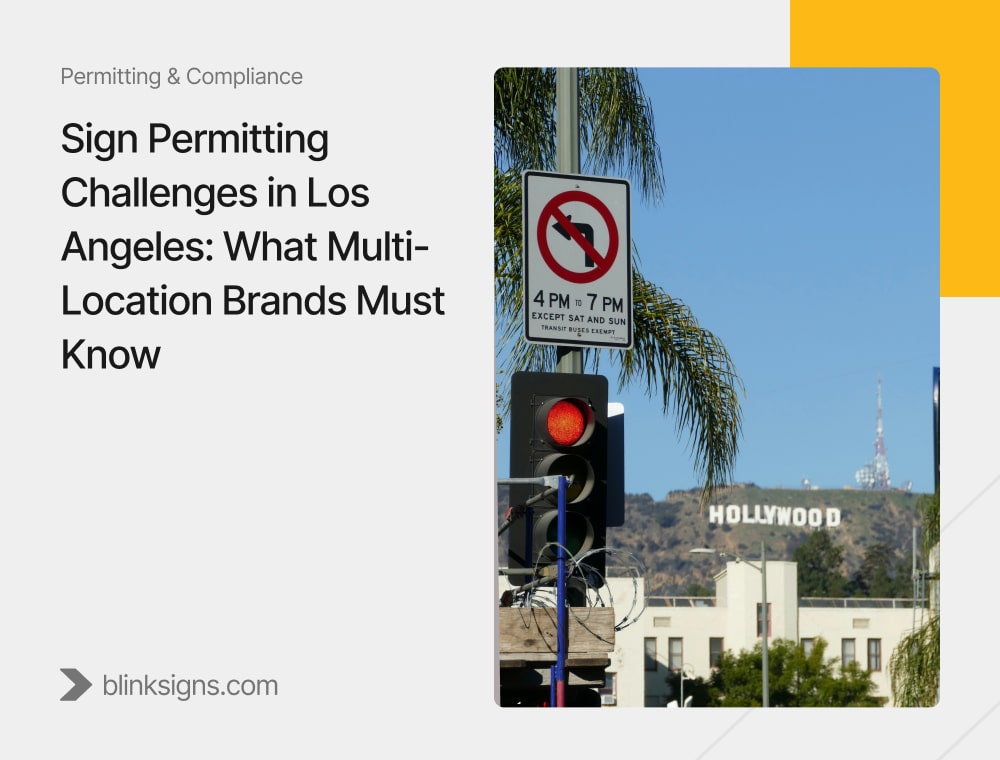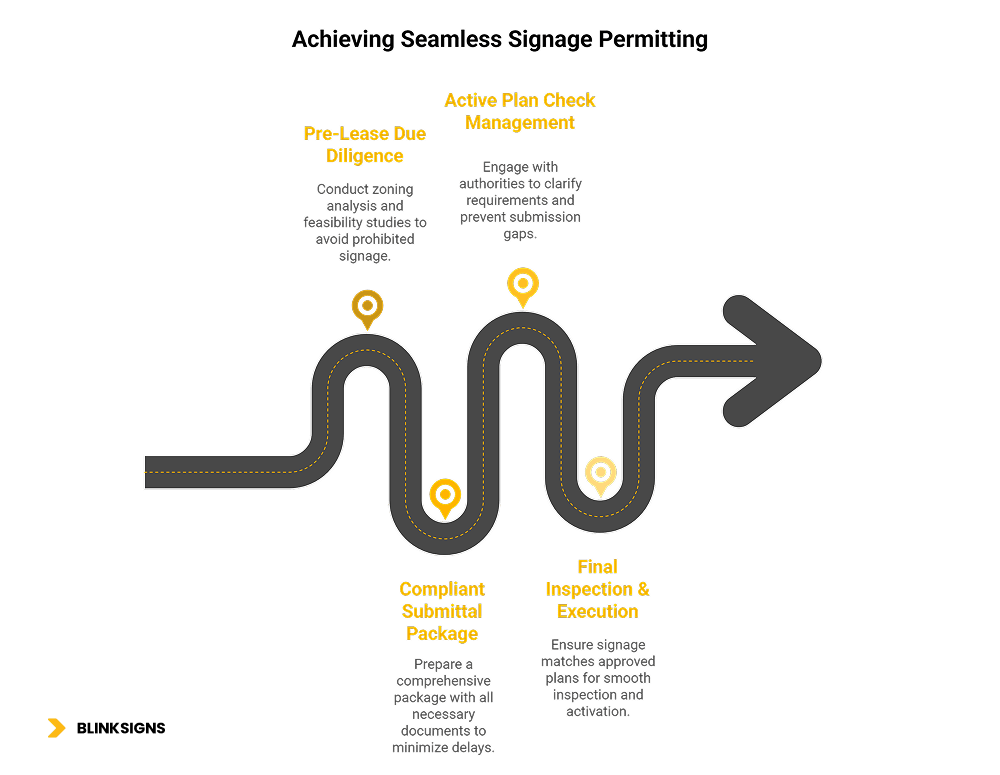
Sign Permitting Challenges in Los Angeles: What Multi-Location Brands Must Know
The LA Rollout Paradox: High Opportunity, Unmatched Complexity
For national and regional brands, expanding in Los Angeles offers unmatched visibility, foot traffic, and brand equity. But what looks like a golden opportunity on paper often becomes a logistical and regulatory minefield.
Los Angeles isn’t one market—it’s dozens. And while your brand seeks consistency, LA’s sign permitting system delivers complexity. From inconsistent feedback loops to hyper-local design codes, launching signage across LA demands more than creative design—it requires regulatory fluency and municipal diplomacy.
“Brands see LA as one city”, says Abhi Goyal, CEO of BlinkSigns.
But the permitting process treats it like 50 jurisdictions. We help unify that chaos, ensuring every sign remains consistent, compliant, and on schedule.”
This guide explores the most pressing challenges multi-location brands face, and what BlinkSigns has learned from helping national clients launch and scale across Southern California without sacrificing brand identity.
Understanding the Regulatory Patchwork: LA Is Not One City

Signage regulation in LA
One of the most common mistakes brands make is assuming that the City of Los Angeles governs all signage within the metro. In reality, your rollout will span municipal boundaries, each with its own zoning rules, permitting workflows, and signage restrictions.
Key Jurisdictions:
- City of Los Angeles (LADBS)
Governed by the Los Angeles Municipal Code (LAMC) and regulated by the Department of Building and Safety, LADBS permits most projects inside LA city proper. - Incorporated Cities
Highly regulated municipalities like Santa Monica, Pasadena, Beverly Hills, and West Hollywood have stricter design review boards and often reject signage that’s permitted elsewhere. - Unincorporated LA County
These areas fall under the LA County Department of Regional Planning, which applies its own zoning and permitting rules.
⚠️ A pylon sign permitted in the Valley may be prohibited just five miles away in Beverly Hills due to height or illumination codes.
Navigating LA’s Complex Zoning & Overlay Maze
Every property in LA carries a base zoning code—but that’s only the beginning. Most commercial corridors fall under Special Use Districts, Specific Plans, or Historic Overlays that override standard signage rules.
The Key Overlays You Must Navigate:
- Historic Preservation Overlay Zones (HPOZs)
These restrict fonts, lighting styles, and materials—often disallowing internally illuminated signs or digital displays entirely. - Specific Plan Areas (e.g., Hollywood SUD)
Highly trafficked zones with unique signage rules. In the Hollywood Signage District, for example, only certain sizes, types, and display durations are permitted. - Community Plan Implementation Overlays (CPIOs)
Designed to protect visual character and walkability. These often impose height limits, restrict colors and brightness levels, and eliminate certain sign types altogether.
Example:
A brand approved for a 100 sq. ft. backlit channel letter sign on Ventura Blvd. may be forced to use dimensional non-lit letters on Colorado Blvd. in Pasadena.
The Most Common Signage Conflicts for National Brands
LA’s codes often challenge the very foundation of franchise brand visibility—requiring adaptation in both form and function.
Common Restrictions:
| Feature | Typical National Brand Design | LA Restriction |
| Pole Signs | Preferred for highway visibility | Banned in most LA commercial zones |
| Illumination | Internal LEDs, halo-lit | Prohibited in HPOZs; brightness regulated |
| Digital Displays (EDCs) | Used for promos & branding | Restricted or banned by most Specific Plans |
| Sign Area | Set per corporate brand standard | Must be calculated by frontage (linear ft) |
The Real Bottleneck: Time-Consuming Permitting Processes
Even if your signage design is fully code-compliant, the permit approval process can introduce weeks—or months—of costly delays.
Common Procedural Challenges:
- Lengthy LADBS Review Timelines
Staffing backlogs and high application volumes delay reviews for signage and tenant improvement plans. - Reviewer Inconsistency
One plan checker may approve your design while another demands revisions for the same project type—creating inconsistencies across locations. - Revisions = Reset
Submitting changes can restart the queue, especially in high-volume areas like Hollywood or Downtown LA, increasing soft costs and delaying brand launches.
The Solution: A Proactive & Strategic Permitting Workflow
Navigating Los Angeles signage permitting isn’t about finding shortcuts—it’s about mastering complexity with foresight, precision, and process. For multi-location brands, success comes from shifting away from reactive problem-solving toward a repeatable, proactive workflow that reduces friction, protects budgets, and preserves brand consistency.

Achieving seamless signage permitting stepwise
Step 1: Pre-Lease Due Diligence
The most important permitting decision happens before a lease is signed.
Conducting a Preliminary Zoning Analysis and signage feasibility study will reveal applicable zoning, overlays (e.g., HPOZs, Specific Plans), sign restrictions, and jurisdictional controls. This ensures you don’t sign for a space where your signature signage; like a pylon or illuminated blade would be prohibited.
❗ Don’t commit blind: Sign restrictions vary dramatically, even within the same ZIP code.
Step 2: A Fully Compliant Submittal Package
Most permitting delays stem from incomplete or non-compliant submittals. An expert-prepared package includes:
- Scaled sign drawings and renderings
- Comprehensive site plans
- Stamped structural calculations
- Landlord approval letter
- All applicable electrical and building permit forms
This ensures your submission clears the first review with minimal friction.
Step 3: Active Plan Check Management
Passive waiting leads to stagnation. Our in-house permit expediters actively engage with LADBS and municipal departments:
- Clarify requirements before they stall progress
- Respond quickly and accurately to corrections
- Prevent plan reviews from restarting due to submission gaps
This proactive posture keeps timelines intact and avoids “permit limbo.”
Step 4: Final Inspection & On-Site Execution
Final approval depends on one thing: your signage must match the approved plans exactly. Our teams manage fabrication and installation to the inch, ensuring a smooth inspection, immediate sign-off, and legal activation.
The LA Signage Playbook: Your Brand’s Blueprint for Scalable Expansion
A site-by-site approach causes delays, rework, and brand inconsistencies. Multi-location success in LA requires a centralized Signage Playbook, a tool that blends brand standards with municipal flexibility.
Your Playbook Should Include:
| Component | Purpose |
| Master Sign Program (MSP) | Defines typography, finishes, and form factors for all signage |
| Design Variations Library | Pre-approved sign types for HPOZs, limited frontage zones, etc. |
| Jurisdictional Requirements Database | Cheat-sheet of city-by-city signage constraints (e.g., West Hollywood vs. Santa Monica) |
| Permitting Workflow Map | Step-by-step process for your internal team to follow at every new site |
A well-built Playbook transforms permitting chaos into predictable execution.
Why National Brands Choose BlinkSigns for LA Expansion
You don’t need to master the Los Angeles Municipal Code. You need a partner who already has.
BlinkSigns delivers:
- Jurisdictional Mastery
We manage permitting across 88 incorporated cities and LA County, from Beverly Hills Architectural Review to LADBS Downtown. - Brand Consistency Through Code Compliance
We customize your Master Sign Program into compliant variants—preserving your brand’s impact without triggering permit denials. - Full-Scope Permit Management
Our dedicated team handles drawings, applications, plan checks, resubmittals, and inspections—all under one roof. - End-to-End Project Accountability
From zoning research to fabrication and install, BlinkSigns owns the entire lifecycle—so your team can focus on opening, not obstacles.
Los Angeles Sign Permitting FAQs
What’s the first step before opening a new LA location?
Run a Preliminary Zoning Analysis before signing a lease. It identifies signage limits, overlays, and hidden constraints upfront.
What’s a Master Sign Program (MSP)?
An MSP is a formal signage blueprint that defines what’s allowed across a multi-tenant property. It governs size, materials, lighting, and branding. We align your signage to comply with or amend MSPs when needed.
How long does permitting take in LA?
Simple signs can clear in a few weeks. Complex signs (with electrical, structural, or overlay zone reviews) may take 2–6 months. Fast approval depends on expert-prepared applications and persistent follow-up.
Can I install a pylon sign in LA?
In most of LA—no. Pole and pylon signs are banned in many commercial zones. We help reimagine your sign into a compliant monument or wall-mounted solution.
Can BlinkSigns help with sign permits outside the City of LA?
Yes. We manage projects across Santa Monica, Pasadena, Burbank, Beverly Hills, and more. Every city has its own process—we know them all.
Eliminate Guesswork from Your LA Rollout
Permitting delays don’t just hurt timelines, they damage brand trust. BlinkSigns helps national brands deliver consistent, code-compliant signage across the most complex metro in America.
Let us turn permitting red tape into smooth rollouts—on time, on brand, and on budget.